Éditeur de la source HTMLRupture de ligne
AREA SETUP
Print various posters related to your theme and use them to decorate your daycare. (Open thematic poster-Environment)
For this theme, you could also create your own thematic poster using a variety of recycled materials or items related to the environment. If you choose to use the thematic poster that accompanies this theme, be sure to laminate it to make it durable and reusable.
Stickers for rewards
(Open stickers-Environment) Print the illustrations on adhesive paper and use them to create stickers that can be given to children to reward them for good behavior.
Educa-theme-Environment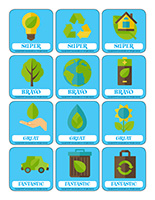
(Open educa-theme-Environment) Print and laminate the elements representing your theme. Use them to present your theme to children (and their parents) while decorating your daycare.
Educa-decorate-Environment
(Open educa-decorate-Environment) Print, laminate, and cut out the items. Use them to decorate the walls of your daycare and set the mood for your theme.
Garland-Planet Earth
(Open garland-Earth Day) Print the models and invite children to decorate them. Cut them out and hang them within your daycare to form a garland. Staple strips of blue and green construction paper, looping them together to create your garland.
Ecological garland
Hang recycled containers from the ceiling within your daycare. During circle time, determine the type of material (plastic, metal, glass, cardboard, paper, etc.) each container is made of with your group.
Recycling-Garbage-Compost posters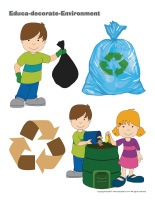
(Open posters-recycling-garbage-compost) Print and laminate the posters. Display them next to your recycling bin, garbage can, and compost bin to help children identify where they must set different types of garbage.
CIRCLE TIME
Animated discussion-Environment
(Open word flashcards-Environment) Print and laminate the word flashcards. Use them to spark a conversation with your group. Ask children questions to determine what they already know about the environment.
Poni discovers and presents-Earth
(Open Poni discovers and presents-Earth) Print the cards. Laminate them and cut them out. Use your Poni puppet (or another puppet children are familiar with) to introduce your group to our planet.
GREETING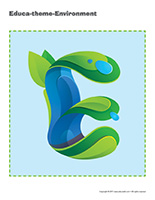
Before children arrive in the morning, set several items from your recycling bin on the floor. Once all the children have arrived and the theme has been introduced, race to pick all the items up and put them back in your recycling bin as quickly as possible. Use this activity to discuss pollution and the advantages associated with recycling and caring for the environment.
PICTURE GAME
The picture game may be used as a memory game or to spark a conversation with the group. The pictures may also be used simply to decorate the daycare or a specific thematic corner. (Open picture game-Environment) Print and laminate. Store the game in a "Ziploc" bag or in your thematic bin.
Memory game-Environment
(Open picture game-Environment) Print the series of illustrations twice and use them for a traditional memory game.
ACTIVITY SHEETS AND WRITING ACTIVITIES
Activity sheets are suggested for each theme. Print and follow instructions. (Open activity sheets-Environment) (Open activity sheets-Earth Day)
Creating a homemade activity booklet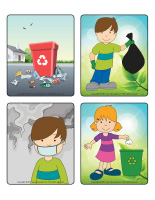
Print and laminate several activity sheets and writing activities. Arrange them in a binder and provide dry-erase markers. Leave the binder in your manipulation area and invite children to complete the activities during free play. The use of dry-erase markers will allow you to use the booklet repeatedly.
Educa-spots-Environment
(Open educa-spots-Environment) Print for each child. Use bingo markers to add color to the different circles. If you don't have bingo markers, children can add stickers or cereal inside the circles.
Writing activities-E like Environment
(Open writing activities- E like Environment) Print for each child or laminate for use with a dry-erase marker.
Stationery-Earth Day
(Open stationery-Earth Day) Print. Use the stationery to communicate with parents, in your writing area, or even to identify your thematic bins.
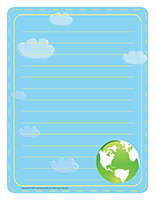
Stationery-Recycling
(Open stationery-Recycling) Print. Use the stationery to communicate with parents, in your writing area, or even to identify your thematic bins.
Educa-nuudles-Earth Day
(Open educa-nuudles-Earth Day) Print for each child. Have children color the sheet and use Magic Nuudles to give it a three-dimensional look. If you don't have Magic Nuudles, simply ask children to fill the spaces with bingo markers or stickers.
Educa-nuudles-Recycling
(Open educa-nuudles-Recycling) Print for each child. Have children color the sheet and use Magic Nuudles to give it a three-dimensional look. If you don't have Magic Nuudles, simply ask children to fill the spaces with bingo markers or stickers. To order Magic Nuudles
VARIOUS WORKSHOPS-Environment
Workshop posters
(Open posters-workshops) Print, laminate, and display to identify your various workshops.
Workshop planning booklet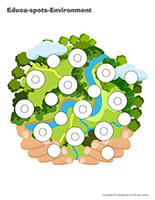
(Open workshop planning booklet) Print, laminate, and use the grid with a dry-erase marker. This essential tool will help you prepare and create the material you need for your various workshops, organize your environment, and plan per the interests of the children in your group. It will also help you analyze your weekly activities.
Workshop follow-up booklet
(Open workshop follow-up booklet) Print for each child. This booklet will help you better understand how workshops foster children's development.
Construction/Building blocks:
- Create unique blocks using cardboard boxes (cereal boxes, milk cartons, tissue boxes, etc.). Simply stuff them with recycled newspaper and wrap them with thick adhesive tape.
- Empty cardboard rolls and tubes (toilet paper, wrapping paper, paper towels, etc.) make great tunnels. Who will build the longest tunnel?
- Cut plastic bottles can also be used to make tunnels.
- Blocks of all kinds can be used to represent our planet, Earth.
- Add blue, brown, and green crayons.
- Recycled materials.
Drawing/Arts & crafts: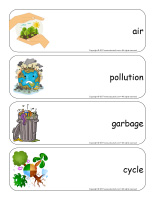
- Use recycled items and materials to make musical instruments.
- Recycle milk cartons and boxes and use them to represent a three-dimensional village model.
- Scraps of paper, pieces of cardboard, etc.
- Individual creations made with recycled materials.
- Blue, green, and brown paint for representing Earth as children see it. They may prefer using other colors...
- Blue, brown, and green paper and recycled materials to create a scale model of Earth.
- Use empty paper towel rolls to make telescopes.
- Adhesive paper, glitter, confetti, and colourful paper can be used to create stained glass decorations that will capture the sun.
- A cardboard circle and pre-cut numbers can be used to represent a clock.
- Stars of all kinds (Fun Foam, stickers, construction paper, etc.) for shiny creations.
- Use star and moon shapes to create a nighttime mobile or sun and cloud shapes to create a daytime mobile.
- Different sizes of construction paper circles that can be used to represent our solar system.
- Coloring pages involving Earth, the environment, recycling, etc.
Role play: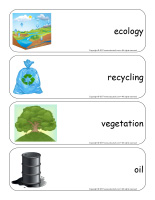
- Add recycled food containers and boxes to your kitchen area.
- Set your cash register in your role play area. Add grocery bags and empty food containers. Children will enjoy pretending they are grocery store employees or customers.
- Set a recycling bin in your kitchen area, just like at home.
- Explore different professions linked to the environment.
- Provide blankets that can be used to build cabins and houses.
- A gardening bin. Children will enjoy playing with dirt, with or without gloves.
Manipulation:
- Memory game involving educatall.com picture game.
- Homemade modeling dough with cookie cutters.
- Maracas made with empty cardboard tubes and tiny recycled items.
- Fabric scraps offering different textures.
- Sort puzzle pieces to identify puzzles with missing pieces.
- Puzzles related to the theme.
- Blue, green, and brown modeling dough. Let children mix them together. Add star-shaped or round cookie cutters.
- Draw a large Earth on cardboard and cut it into pieces to create an oversized puzzle.
- A globe.
Reading/relaxation: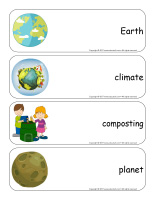
- Books about nature, trees, paper transformation.
- Magazines of all kinds. Ask parents to give you magazines they would normally have put in their recycling bin.
- Reference books about the environment.
- Hang tiny lights and tulle in your reading area to create a special hideout.
- Aerial pictures of Earth.
Music and motor skills:
- Parade around your daycare with the musical instruments made in your arts & crafts workshop.
- Recycled item race. Fill a bin with recycled items and set three empty bins at the opposite end of the room (paper, cardboard, plastic). As a team, children race to sort the items.
- Plastic bottles can be used as bowling pins.
- An obstacle course involving objects related to the Earth. Children must collect them along the course.
- Parachute games involving sun, cloud, moon, and star shapes. Children will love to send them flying in the air.
- Parachute game with scraps of paper or balls of recycled paper.
- Balls in different sizes to represent the Earth, the Sun, the Moon. Children will like to roll them, toss them, bounce them, etc.
- Spin a ball on your finger to represent the Earth spinning on its axis.
Sensory bins: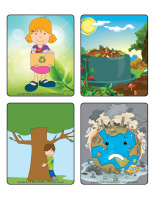
- Bin filled with scraps of different types of paper, hole-punches, and scissors.
- Water table children can use to "wash" doll clothes or with recycled water bottles they can fill and empty.
- Sand table with empty plastic bottles and containers.
- Bin filled with mismatched toys and parts...children will love finding new uses for the items.
- A large container filled with dirt.
- A large ball of modeling dough.
Early science/kitchen:
- Everything you can find that is related to nature.
- Prepare a simple bread pudding or trifle recipe to use up leftover food items.
- Experiment color combinations and try to create green and brown paint.
- Use magnifying glasses to observe pictures of Earth.
- A globe children can spin to find where they live.
- A real telescope.
LANGUAGE ACTIVITIES
Word flashcards-Environment
The flashcards may be used during circle time to spark a conversation with the group or in your reading and writing area. They may also be used to identify your thematic bins. (Open word flashcards-Environment) (Open giant word flashcards-Environment) air, pollution, garbage, cycle, ecology, recycling, vegetation, oil, Earth, climate, composting, planet
Let's chat
(Open word flashcards-Environment) (Open giant word flashcards-Environment) Print and laminate the word flashcards. Have each child pick a flashcard and take turns presenting the item to the group. Discuss each item to see what children know about the theme.
Reinvented scrabble
(Open word flashcards-Environment) (Open giant word flashcards-Environment) Print many copies of the word flashcards and encourage children to use scrabble tiles to write the words. Manipulating the small tiles represents a great fine motor skill exercise. At the same time, children will notice which letters make up the different words.
Word association-Environment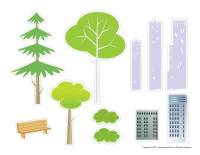
(Open word flashcards-Environment) (Open giant word flashcards-Environment) Print two copies of several different word flashcards. On a large piece of cardboard, stick one copy of each flashcard vertically to create a word column. Cut the second copy of each word flashcard so you have the word on one side and the illustration on the other side. Attach Velcro behind each part as well as to the right of the uncut flashcards (on the cardboard). Arrange the cut flashcards on the table and encourage children to look at your flashcard board to identify a matching word and illustration. When they succeed, they may stick them next to the corresponding flashcard, on your board. This exercise will help children associate words with pictures.
Word tree-Environment
(Open word flashcards-Environment) (Open giant word flashcards-Environment) Print several word flashcards. Use a hole-punch to make a hole at the top of each flashcard. Thread a ribbon through each hole and tie a knot. Bring the word flashcards outside and encourage children to use them to decorate a tree. Every time a child adds a flashcard, invite him/her to "read" the corresponding word. Children will be happy to repeat this activity many times. Eventually, they will learn to recognize the words.
Word clothesline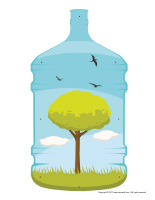
(Open word flashcards-Environment) (Open giant word flashcards-Environment) Print two copies of several word flashcards. Hang one copy of each word on an indoor clothesline with colourful clothespins. Arrange the copies in a pile on a table. Let children take turns picking a word and finding the matching word on the clothesline. When they find a match, they can place the flashcard on top of the one that was already hanging on the clothesline. Help younger children manipulate the clothespins if necessary.
Word race
(Open word flashcards-Environment) (Open giant word flashcards-Environment) Print several word flashcards and hide them throughout your daycare or yard. Divide your group into two teams. When you give them the signal, children must search for the flashcards for a pre-determined period, for example three minutes. When the time is up, children must be able to "read" their flashcards to earn a point for their team. If they are unable to find the correct word, the other team can earn the point if they succeed.
My neighbourhood scene
(Open scene-My neighbourhood) Print, laminate, and cut out the pieces. Let children use the items to decorate the scene.
ROUTINES AND TRANSITIONS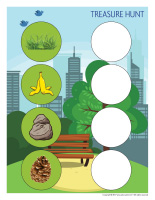
Game-This is my spot-Environment
(Open picture game-Environment) Print each illustration twice. Use adhesive paper to secure one copy of each illustration on the table. Deposit the second copy of each illustration in an opaque bag and invite children to pick a card that will determine their spot at the table (corresponding illustration). The illustrations can also be used to determine children's naptime spots or their place in the task train.
Ecological towel
Give each child a hand towel and provide fabric markers. Invite each chid to customize his or her towel. Children will enjoy wiping their hands on their towel during your handwashing routine. If possible, hang hooks next to the sink so each child can hang his towel on his own hook.
Reusable drinking glass
Purchase a plastic drinking glass for each child. Provide permanent markers and encourage each child to draw on his or her drinking glass. Older children can write their name. Children will be able to quickly recognize their glass and use it to drink water throughout the day.
To each his own responsibility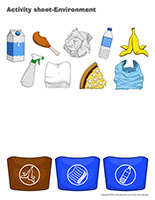
(Open task chart) Print and laminate. Every day, give each child a different responsibility (recycling, watering flowers, distributing towels, distributing water, cleanup inspector, etc.).
Earth hop
Set Earth illustrations on the floor. Have children jump from one illustration to the next in a variety of different ways: on one foot, on two feet, like a frog, backwards, etc. Every hop will build children's motor skills.
Giant hopscotch
Use colourful adhesive tape to draw a giant hopscotch grid on the floor. If you wish, it can connect two rooms or two areas children visit frequently. Teach children to alternate hops on one foot and hops on two feet. Draw items related to the environment in each box.
PHYSICAL ACTIVITY AND MOTOR SKILLS
String activities-Environment
(Open string activities-Environment) Print for each child. Children trace the outlines with white glue before covering them with colourful string.
Surprise tunnel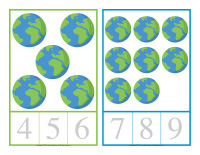
Glue two or three empty paper towel rolls end to end. Set one end of your tunnel on a chair and set the other end on the floor. Encourage children to slide toy cars, small balls, cotton balls, or figurines through it.
Lacing-Recycling
(Open lacing-Recycling) Print, laminate, and punch holes all the way around the models. Children can use string, ribbon, or a shoelace to lace them.
Walking on stilts
Build simple stilts using empty metal cans. Make a hole on either side of each can, close to the bottom. Measure two long pieces of rope and thread one end of each rope in one of the holes. Secure the rope inside the cans with knots. To walk on the stilts, children must stand on the bottom of the cans, holding the ropes in their hands. It isn't as easy as you may think! Certain children may need a lot of practice. Make sure the edges of the cans aren't sharp. You may add heavy tape for extra protection.
Brown bags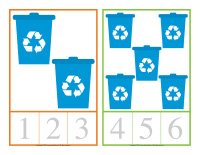
Set brown paper bags on the floor to create an obstacle course. Children must hop from one bag to the next. At the end of the obstacle course, have them toss a brown paper bag in the air. They must catch it before it touches the floor. If they don't succeed, they must start over, from the beginning.
Recycled constructions
In your construction area, provide a wide range of empty plastic containers and cardboard boxes. Children will love using them to build castles and other structures. Your local grocer will be happy to give you boxes. Children will spend hours building tunnels, houses, towers, etc. When they are done, encourage them to use the boxes and containers to store toys and items within your daycare.
Recycling race
(Open I recycle well) Print. Prepare four boxes and glue one picture on each box to represent the different categories: plastic, glass, metal, and paper. Divide your group into two teams and give each team a bag containing the same number of objects. Determine a start and finish line. Set your four boxes at the finish line. A child from each team picks an item out of his or her team's bag, runs to the finish line, and places it in the correct box. The first team who successfully sorts all its items wins.
Recycled basketball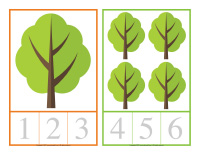
Crumple several pieces of paper with the help of the children in your group. Each child must have a different color of paper balls. Children stand in the centre of your daycare and try to toss their balls of paper in a brown paper bag set a few feet away. The game continues for the duration of one song. At the end of the song, the child with the most balls of paper in the bag wins.
Bowling game
Make your own bowling game using empty 2-litre plastic bottles. Paint the bottles with poster paint and use a soft ball or a tennis ball to play.
Spinning like the Earth
Set several exercise mats on the floor and encourage children to perform somersaults to "spin" like the Earth.
The Earth spins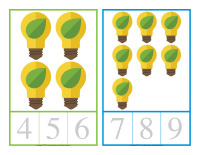
Divide your group into teams of three children. One child represents the Earth, another child represents the Moon and the third child represents the Sun. The child from each team who represents the Sun remains perfectly still. The children who are the Earth must spin while moving around the Sun. The children who are the Moon must also spin while moving around the Earth. Variation for younger children: Divide your group into teams of two and have the Earth spin around the Sun.
OUTDOOR ACTIVITIES
Environmental treasure hunt
(Open environmental treasure hunt) Print and laminate. Look at the items that must be found with your group and name each one. Give each child a reusable bag and invite them to explore a nearby forest as they search for the items.
A town somewhere on Earth
Collect several cardboard boxes (appliances). With your group, use them to represent a town. Children can paint bricks on the boxes to represent houses, bars to represent a prison, signs to represent stores, etc.
Recycling fun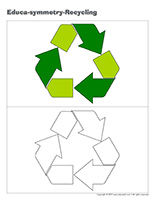
Provide a wide range of empty plastic containers and cardboard boxes. Children will love using them to build castles and other structures. Your local grocer will be happy to give you boxes. Children will spend hours building tunnels, houses, towers, etc.
An ecological walk
Go for a walk in your neighbourhood with your group and count the recycling bins.
Visiting Earth
Use hula hoops, balls, cardboard boxes, etc. to create an obstacle course. Invite children to complete the course, pretending they are aliens discovering Earth for the first time.
From one continent to the next
Set five hula hoops on the floor, in a line (or draw five circles with rope). Have children stand around the hula hoops (continents). They can take turns hopping from one continent to the next to the sound of fast-paced music. When the music stops, the child who is in a hula hoop must remain in it. The game continues until all the children land on the same continent.
The Earth is round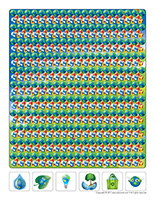
Give each child an inflated balloon. Let them draw on it. Show children how they can spin their balloon, just like Earth.
COGNITIVE ACTIVITIES
Counting cards-Environment
(Open counting cards-Environment) Print and laminate. Prepare a series of wooden clothespins on which you can paint or draw numbers 1 to 9. Children count the items on each card and place the corresponding clothespin on the correct number.
Educa-symmetry-Recycling
(Educa-symmetry-Recycling) Print. Children must color the picture on the bottom to make it look exactly like the picture on the top.
Educa-symmetry-Earth Day
(Educa-symmetry-Earth Day) Print. Children must color the picture on the right to make it look exactly like the picture on the left.
Educ-intruder-Earth Day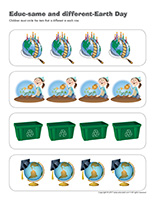
(Open educ-intruder-Earth Day) Print and laminate. Children must find the six items.
Educ-same and different-Earth Day
(Open educ-same and different-Earth Day) Print and laminate for durable, eco-friendly use. Children must circle the illustration that is different in each row.
Bingo-Earth Day
(Open bingo-Earth Day) Print and play bingo with your group. Invite parents and grandparents to join you. Store the cards and tokens in a Ziploc bag.
Educ-trace-Earth Day
(Open educ-trace-Earth Day) Print for each child. Children must trace the lines using a crayon of the designated color and then color the item at the end of each line with the corresponding color.
Educ-trace-Recycling
(Open educ-trace-Recycling) Print for each child. Children must trace the lines using a crayon of the designated color and then color the item at the end of each line with the corresponding color.
My recycling book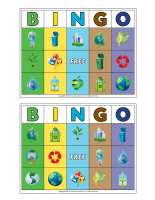
Staple several sheets of paper together to form a book for each child in your group. Provide several magazines, catalogues, and flyers. Have them search for and cut out pictures or illustrations representing items that can be recycled. They can glue them in their book.
Shape box
Recycle different boxes to create an educational game. Cut a variety of shapes out of the sides of each box and set the cut-out shapes on a table. Children take turns picking a shape, naming it, and inserting it in the corresponding hole.
Where things are made
(Open world map and flags) Print and laminate. Present the map to your group. Select a variety of objects available within your daycare (clothing, toys, furniture, etc.). Read the labels to determine the country where they were made and identify it on the map.
Animal environments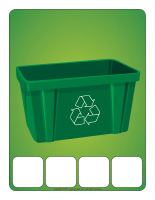
(Open association game-animal environments) Print and laminate. Introduce your group to the different environments in which animals live. Set the animal illustrations upside down on a table and invite children to take turns picking a card, naming the animal, and associating it with the correct environment.
Hunt and seek-Environment
(Open hunt and seek-Environment) Print and laminate. Children must find and circle the pollutants with a dry-erase marker.
Recycle, discard, or compost
(Open game-I recycle, discard, compost) Print the posters and illustrations. Laminate them for durable, eco-friendly use. Display the three posters on a wall. Children take turns picking an illustration and sticking it on the correct poster depending if the item must be recycled, put in the garbage, or composted.
Gift bag puzzles
Recycle gift bags by wrapping them with adhesive paper and cutting them into three or four pieces. Who will complete their puzzle the fastest?
Sorting items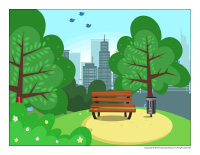
Deposit several different items in a paper bag or cardboard box. Select items children are familiar with and offer a variety of textures and sizes. Have them take turns picking an object out of the bag or box while blindfolded. Encourage them to try to identify the objects. Once they have succeeded, determine whether each item is recyclable or not.
I am learning to recycle
(Open I recycle well) Print. Prepare four boxes and glue one picture on each box to represent the different categories: plastic, glass, metal, and paper. Sit in a circle with your group. Set a variety of different objects in the centre of the circle (plastic bottles, shoeboxes, glass bottles, metal cans, etc.). Identify which bin each item belongs in with your group.
Educ-pairs-Recycling
(Open educ-pairs-Recycling) Print. Children must draw a line between identical items or color them using the same color. For durable, eco-friendly use, laminate the document and use it with dry-erase markers.
Educ-colors-Earth Day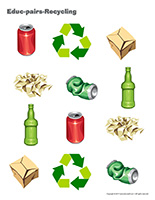
(Open educ-colors-Earth Day) Print and laminate for durable, eco-friendly use. If you prefer, print the document for each child. Children must associate each item to the correct color by drawing a line between them using the corresponding color.
Educ-shadows-Earth Day
(Open educ-shadows-Earth Day) Print and laminate for durable, eco-friendly use. Children must find the shadow that matches each item on the left and connect them by drawing a line.
Educ-differences-Earth Day
(Open educ-differences-Earth Day) Print and laminate for durable, eco-friendly use. Children must find the number of differences indicated and circle them with a dry-erase marker.
Educ-math-Earth Day
(Open educ-math-Earth Day) Print and laminate for durable, eco-friendly use. Children must count the items in each rectangle and circle the corresponding number.
Association game-Earth Day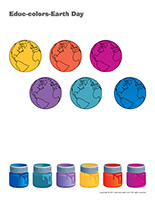
(Open association game-Earth Day) Print the game. Children must associate the cards to the correct illustration.
Hunt and seek-Earth
(Open hunt and seek-Earth) Print and laminate. Children pick a card and search for the item in the scene.
Find Earth
(Open game-Find Earth) Print, laminate, and cut out. Hide the sun, moon, and star cards throughout your daycare. Hide a single Earth illustration. When you give the signal, children hunt for the items. The goal of the game is to find the Earth. The child who finds it can hide the cards for the next round.
Save the planet
(Open game-Save the planet) Print and laminate the cards. Arrange them upside down on the table. Children take turns picking a card and determining if the illustrated action helps save the planet or not. If they are correct, they may keep the card. The game ends when there are no more cards. Children count their cards to see who won.
Continents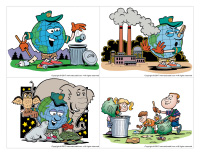
(Open activity sheets-Continents) Print for each child. They must color the continents by associating the colors.
The globe
Set a globe on a table along with books about different countries containing plenty of pictures. Hang a map of the world on the wall, at children's level. Encourage children to try to find different countries.
MUSICAL AND RHYTHMIC ACTIVITIES
Earth hopping
(Open model-Earth) Print. Laminate the models and secure them on the floor with adhesive paper. Play music. Every time the music stops, children must sit on an Earth illustration (variation of musical chairs).
Recycled sound
Fill a grocery bag with several different recycled items that produce sounds (crumpled brown paper bags, metal cans and plastic spoons, etc.). Let children explore the various sounds.
Musical bag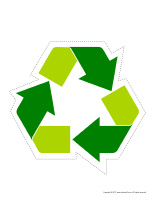
Set several brown paper grocery bags on the floor. You must have one bag less than the number of children in your group (for a group of six children, you will need five bags). To the sound of music, children walk or dance around the bags. When the music stops, they rush to sit on a bag (variation of musical chairs).
Musical instruments
You will need six to eight glass jars from your recycling bin (or items from your kitchen). Leave one jar empty and fill the other jars with different levels of water. The last jar must be completely full. Let children tap the jars with a wooden or metal spoon to discover different sounds. Line the jars up in order, from the highest to the lowest pitch.
Variation: You may also add different objects such as a metal can, a cardboard box, or plastic container to your lineup to explore different types of sounds.
Recycled guitar
Make a guitar out of an old shoebox. Cut a hole with a diameter of 8 cm out of the centre of the lid. Put it back on the box and slide six rubber bands over the hole. Children will enjoy pinching the elastics to produce different sounds.
MORAL AND SOCIAL ACTIVITIES
The environment is important at home too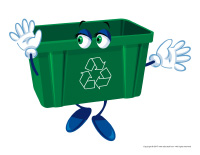
Ask parents to collect recyclable items at home with their child and bring them to daycare. You can print this list to help them find items for this activity. (Open poster-list of recyclable items) Use the items they provide to create new objects (storage boxes, stilts, musical instruments, etc.). The items can also be sorted by your group.
ACTIVITIES INVOLVING PARENTS
The gift of seeds
For a special occasion, prepare a gift children will be proud to offer. Select different flower or herb seeds. Deposit them in brown paper bags. Have children draw the corresponding flowers or herbs on their bag.
Garbage patrol
Invite parents to join you for a walk in your neighbourhood to raise everyone's awareness about pollution. Purchase rubber gloves for everyone and collect any garbage you find along your path. Be sure to ask children to show an adult their findings before touching them for safety reasons. At the end of the activity, invite children to draw what they saw during the outing.
I protect the environment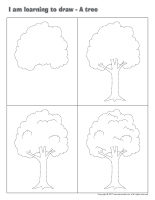
Prepare a large piece of green construction paper. At the end of the day, invite children to flip through catalogues, magazines, or flyers they have at home in search of items linked to protecting the environment. During circle time the next day, they will be proud to share their findings with the group.
EARLY SCIENCE/MANIPULATION/EXPLORATION
Different fabrics, different textures
Collect several fabric scraps offering a variety of textures. You can, for example, cut old clothing items. With your group, create an original texture book by gluing a different type of fabric on each page. Use yarn to connect the pages.
Mud!
Fill a container with mud and let children play in it with their hands and different accessories such as shovels, empty yogurt containers, spoons, etc.
The colors of the Earth
You will need coffee filters, a mixture of water and food coloring (two containers, one with blue and one with green), and eyedroppers. Invite children to use the eyedroppers to deposit blue and green drops of water on the filters. Encourage them to watch the reaction. Set the coffee filters aside to dry. They will look like Earth.
Metal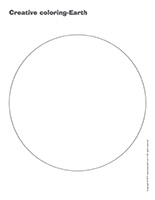
Set a variety of objects on a table (examples: nails, paperclips, aluminum paper, crayons, blocks, lipstick, etc.). Encourage children to hold a magnet next to one item at a time. Have them place the items attracted to the magnet on one side and the items not attracted to the magnet on the other side. Help children understand how metals are attracted to magnets.
Magnetic memory game
Recycle the tops of frozen juice cans and use them to create a memory game. Stick pictures from the educatall.com picture game on them, making sure you have two copies of each one. Arrange them upside down on a table or the floor. Children take turns turning two lids. The goal is to find matching pictures.
Water is important
Purchase dried fruits or vegetables (for soup) and place them in a clear container filled with water. Children will experiment dehydration and rehydration. Set apple and orange slices out to dry. Serve dried fruit at snack time. Take advantage of this activity to water your plants with children to explain the importance of water. To complete your activity, serve each child a tall glass of water.
Glacier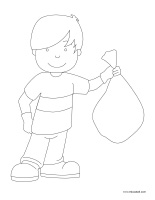
Purchase a bag of assorted balloons. Fill them with water and set them in the freezer. Once the water is frozen, tear the balloons off the frozen balls. Set the balls of ice in a kiddie pool or in a large container. Let children manipulate them. Observe the glaciers as they go through a transformation (melt away).
CULINARY ACTIVITIES
Collecting seeds, pits, and stones
Keep the seeds, pits, and stones from the fruit you serve at snack time (melons, pumpkins, apples, tomatoes, avocado, etc.). Let children wash them to remove all pulp clinging to them and set them on a sunny windowsill to dry. Once they are dry, place them in a sealed jar or plastic container. Label the containers and plant them in your garden in the summer.
Earth cookies
Prepare sugar cookies and use round cookie cutters (or a drinking glass) to create little planet-shaped cookies. Decorate them with green, blue, and brown icing.
ARTS & CRAFTS
Puppets-Earth Day
(Open puppets-Earth Day) Print the puppet models on cardboard. Have children cut them out and decorate them with various arts & crafts materials. Stick a Popsicle stick behind each one to complete your puppets.
Models-Recycling
(Open models-Recycling) Print and use the various models for your crafts and activities throughout the theme.
Models-Earth
(Open model-Earth) Print and use the various models for your crafts and activities throughout the theme.
I am cutting circles-Round like Earth
(Open I am learning to cut circles) Print for each child. Throughout the week, let children practice cutting circles. Explain how circles our round, like our planet Earth.
Earth
Draw a large circle on a piece of white cardboard. You will need blue and green paint as well as sponges (or other painting tools). Ask children to paint the circle to make it look like Earth. Display their artwork on a wall and write "We love Earth" above it. Stick tiny pieces of paper around your planet Earth and encourage parents to write small actions that will help keep Earth clean. Read the suggestions to your group during circle time.
Mrs. Earth
(Open craft-Mrs. Earth) Print. Have children color and cut out the parts. Use the planet to represent your character's head and body. Fold pieces of paper accordion-style to represent arms and legs. Glue a medium-sized flower to the end of each strip of paper (hands and feet).
Crumpled planet
(Open craft-Earth) Print for each child and glue the model on cardboard. Encourage children to fill the different sections with blue and green pieces of crumpled tissue paper.
Stained glass Earth
Draw a circle the size of a dinner plate and cut out the centre. Stick a piece of adhesive paper on one side of the plate. Turn it over and have children press blue and green pieces of cellophane paper on the sticky side. Hang children's work in front of a window.
Earth clock
(Open clock-Earth) Print and cut out the pieces. Have children stick the Earth illustration on a paper plate and add the numbers all the way around the contour. Make sure they place the "12" at the top and the "6" at the bottom. Make a tiny hole in the centre of the plate and insert a fastener to hold the hands in place.
Recycled clothing
Use an old sock to create a snake. Simply stuff it with newspaper scraps and use a string to seal the open end. Glue wiggly eyes and a felt tongue. Add stripes, polka dots, and designs. If you wish, add tiny bells to create a rattlesnake. Have fun finding a name for your snake.
Recycled shoes
Give each child two empty tissue boxes they can transform to create special recycled shoes. Use a hole-punch to make holes on either side of the opening on each box. Children can thread a shoelace through the holes and decorate them with recycled materials. Variation: Ask children to bring an old pair of shoes to daycare. Let them paint the shoes. They can add wiggly eyes, feathers, buttons, etc. Set them on a shelf for everyone to see.
Recycled sweater
You will need a brown paper bag. Cut a hole in the bottom of the bag (for the head) and a hole on either side of the bag (for the arms). Children decorate their sweater with ribbon and fabric scraps.
Reusable bags
Recycle fabric with this activity. Use large rectangular pieces of fabric to create reusable bags. Simply fold them and glue or sew the edges together. Add fabric handles to each bag. Have children decorate them with fabric markers. You can make shoe bags or larger bags for errands. Explain to your group how these bags can replace disposable plastic bags.
COLORING PAGES
I am learning to draw-Earth
(Open I am learning to draw-Earth) Print and laminate the model sheet. Invite children to practice their drawing technique on the model sheet before trying to draw Earth independently.
Complete the drawing-Recycling
(Open complete the drawing-Recycling) Print for each child. Children must draw the missing parts or items.
Complete the drawing-Earth Day
(Open complete the drawing-Earth Day) Print for each child. Children must draw the missing parts or items.
Creative coloring-Earth
(Open creative coloring-Earth) Print for each child. Ask children to complete the picture by drawing their house on the globe.
Creative coloring-Earth Day
(Open creative coloring-Earth Day) Print for each child. Ask children to complete the picture as they see fit. (Open coloring pages theme-Environment) (Open coloring pages theme-Recycling) Print for each child.
DIFFERENT WAYS TO USE THE COLORING PAGES
Identical coloring pages-Environment
Print the same coloring page for each child and an additional copy for your model. Color only certain parts of your picture. Present the model to your group and ask them to color their picture to make it look exactly like yours.
Coloring binder-Environment
Print and laminate several coloring pages and arrange them in a binder with a few dry-erase markers. Leave everything on a table for children to explore.
Musical drawing-Environment
Play musical drawing with your group. Give each child a coloring page. Have children sit around a table. When the music starts, they must pass the coloring pages around the table. Every time the music stops, they must color the picture in front of them until the music starts again.
Homemade puzzles-Environment
Give each child a picture to color. When they are done, cut each picture into pieces to create unique puzzles.
SONGS & RHYMES
Pretty, pretty planet Earth
We will take good care of you
Reduce waste and recycle
Keep land green and oceans blue
Pretty, pretty planet Earth
We will take good care of you
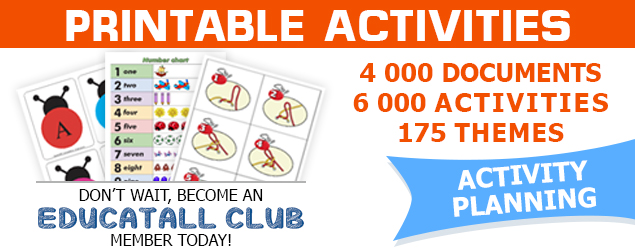
 Home
Home Theme activities
Theme activities
 Babies and toddlers
Babies and toddlers
 Arts and crafts
Arts and crafts
 Science
Science
 Creative recipes
Creative recipes
 Tips and tricks
Tips and tricks
 Special needs
Special needs
 Extra activities
Extra activities
 Educ-TV
Educ-TV
 Newsletter
Newsletter  Online store
Online store Educatall club
Educatall club

